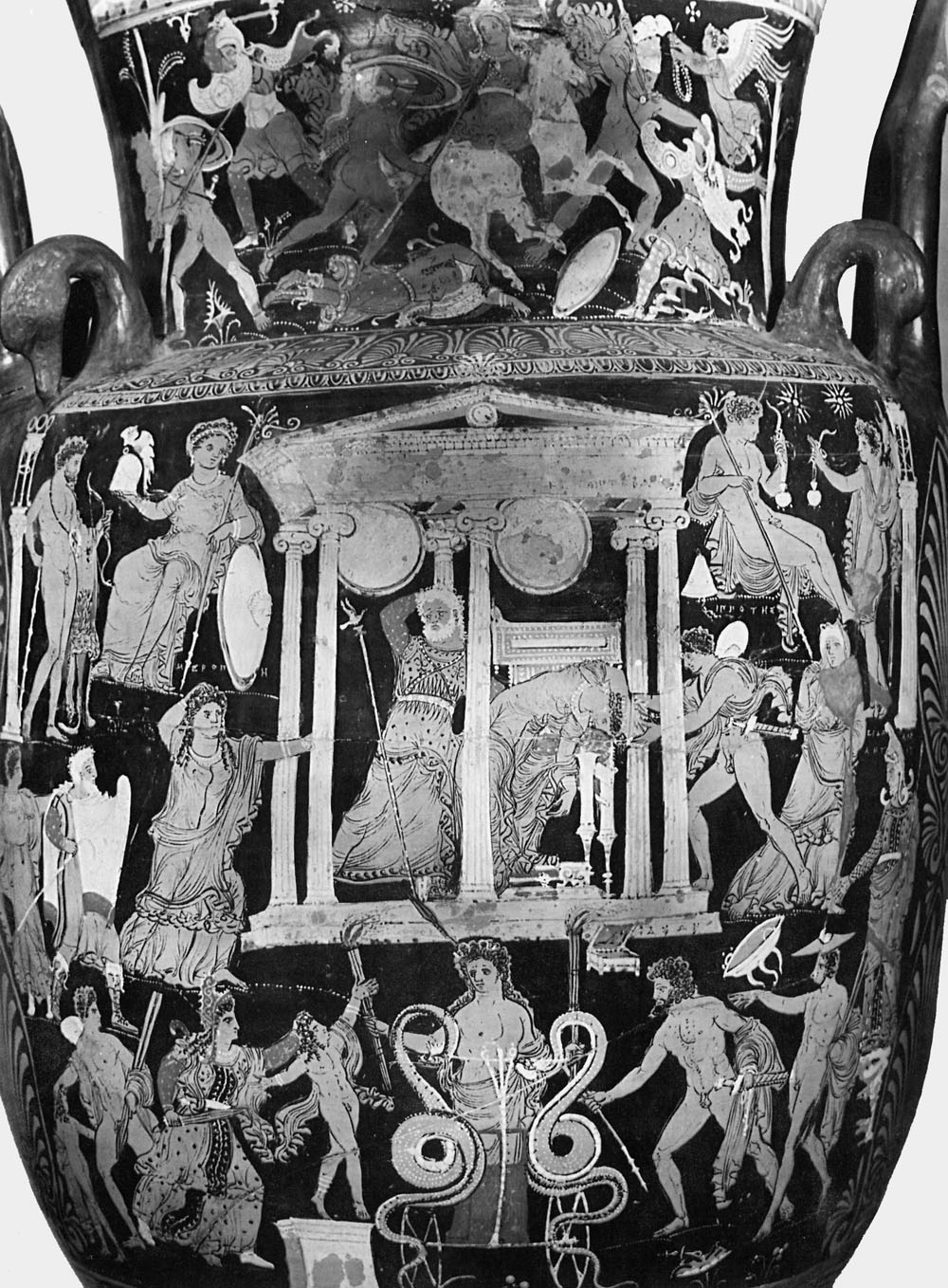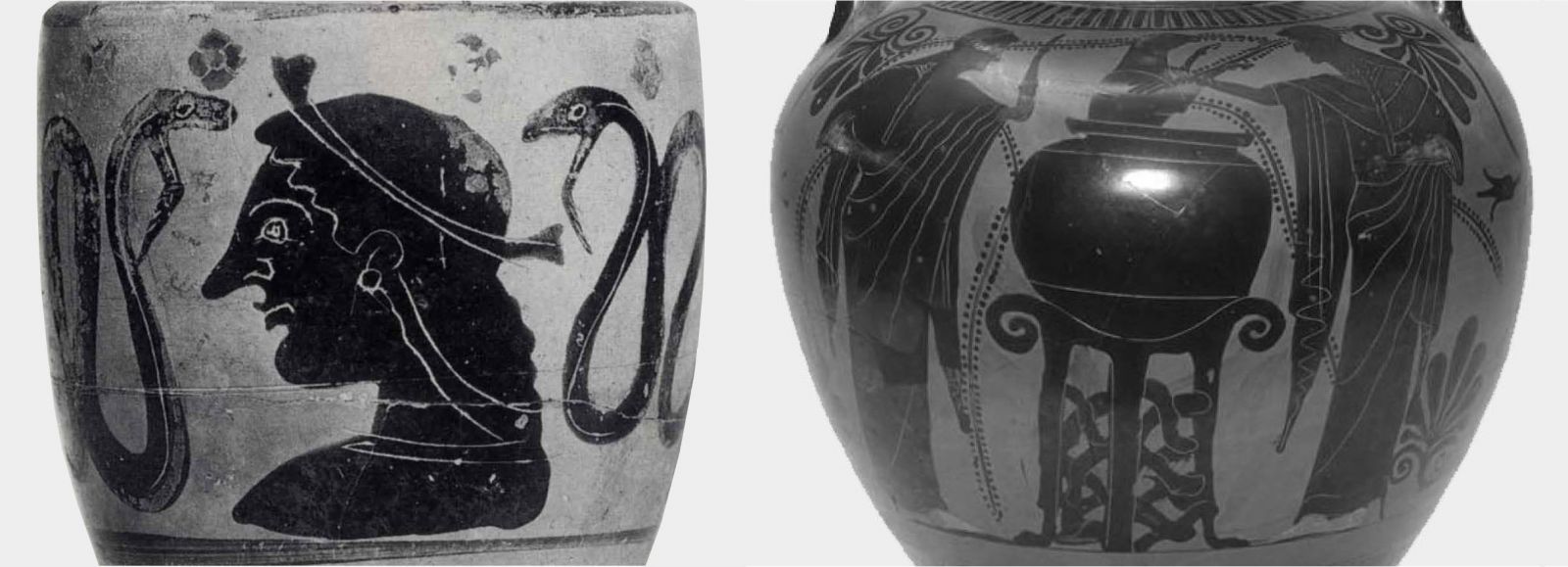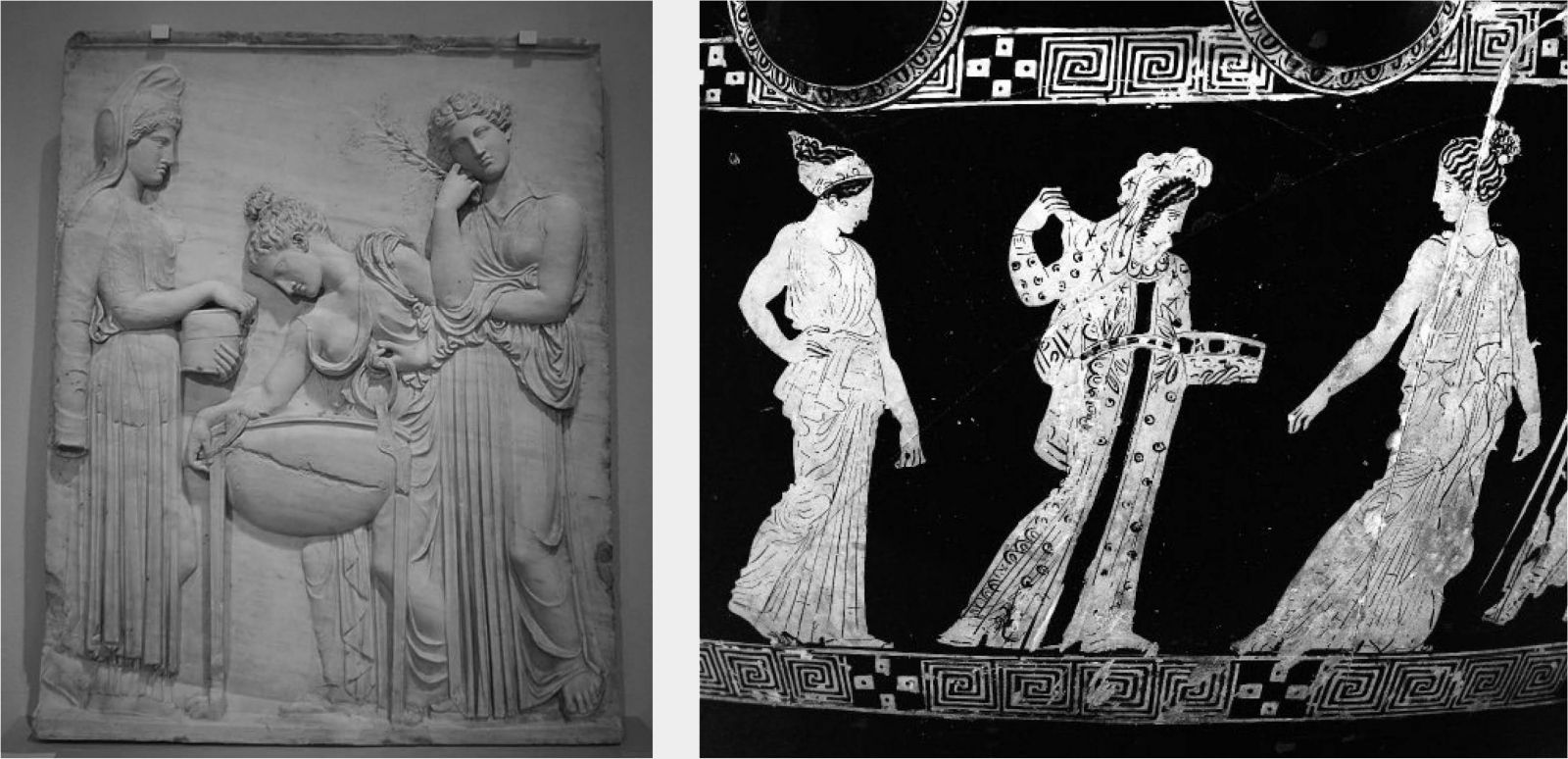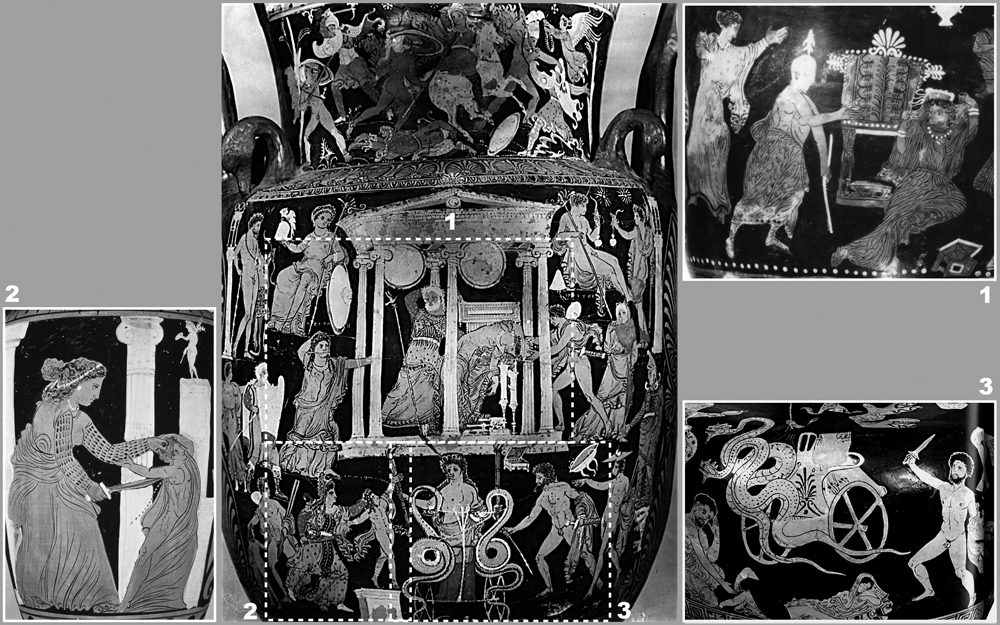The Underworld Painter and the Corinthian adventures of Medea
An interpretation of the crater in Munich
Ludovico Rebaudo
English abstract

(fig. 1) Medea’s adventures in Corinth, apulian r.f. volute-crater from Canosa. Attributed to the Underworld Painter, ca 320 BC. Munich, Staatliche Antikensammlungen 3296.
The volute-crater now in Munich (Antikensammlungen 3296: fig. 1), found in 1813 in the chamber grave of a Daunian warrior in Canosa di Puglia (Millin 1816; Mazzei 1991; Mazzei 1992), is one of the best known and most reproduced south-italian pots. It is attributed to the Underworld Painter and dated between 330 and 310 BC. (RVAp II, 533, nr. 283; RVAp II Suppl. 1, 69; Todisco 2003, 482-83, cat. Ap 219; on the Underworld P.: Todisco 2012, 201-203 with further bibl.)
In the midpoint of the side A the painter has represented the death of Glauke, named KΡEONTEIA (“daughter of Kreon”) on the entablature of a naiskos in which we recognize the Corinthian royal palace. Glauke is falling down from throne, poisoned by Medea’s gifts, the πέπλο πωλυτελῆς and στέφανος χρυσέος (Med. Argum. III). Her father Kreon, also identified by an inscription (KΡEΩN), is trying to held her up, raising his right hand above his head in a very usual gesture of despair. Her mother (MEΡOΠΗ) is rushing over from left in a quite comparable attitude, probably crying out by horror. Behind Merope, at the far left, the old pedagogue identified by his typical elaborate, half-slavish clothes is in turn approaching the palace followed by a young woman, probably a maidservant. On the other side Glauke’s older brother (ΙΠΠOTΗS) is coming to the aid from right and desperately tries to pull out the poisoned crown from his sister’s head. Behind him a horrified, white-haired woman is flying away.
In the upper zone we find gods and heroes, a recurrent presence in Late Apulian ambitious compositions like this: Herakles standing and Athena sitting on the left; the Dioskouroi in the attitude of athletes with aryballoi and strigiles, identified by stars and traveller’s hut (pileus) on the right.
The lower zone is focused on Medea. Dressed with typical oriental clothes (double chiton with embroidered sleeves of a different fabric, himation and tiara), she has grabbed by the hair one of her sons and is about to kill him on a βομόϲ. The other son seems to be rescued or provisionally protected by a young soldier holding two spears. At the center the chariot of Medea’s grandfather Helios, hauled by two snakes, is drived by a young man bearing two flaming torches and glimpsing the murder’s scene. This is labelled ΟΙΣ[Τ]ΡΟϹ and is a daemon or, perhaps better, the personification of “fury” or “frenzy”. A furious Jason is rushing up from the other side. He bears spear and sword but he cannot prevent the impious crime and stares at Medea angrily and powerless. Far on the right, at a intermediate level between middle and lower zone, is a imposing male figure whose oriental dress looks very much like that of Medea. Surprisingly enough the man is labelled ΕΙΔOΛΟΝ AΗΤΟΥ. He is than the ghost of Medea’s father Aietes. The gesture of his right hand entails that he is speaking any words but it is unclear to whom the speech is addressed.
Since the late nineteenth century it has been assumed that the picture was strongly influenced by – if not a ‘illustration’ of – a tragic performance. Scholars like Carl Robert and Louis Séchan had no doubt about the reliance on Euripides’ Medeia performed in 431 BC (Robert 1881, 37; Huddilston 1898, 47; Séchan 1926, 405-422), but many others assumed that it was more probably inspired by another play, now lost (e.g. Vogel 1886, 148-150; Trendall, Webster 1971, III.5.4). In Pots and Plays sir Oliver Taplin defines this vase «plausibly related to a Medeia tragedy, but not that by Euripides» and considers it «almost a textbook repository» of the tragic signals existing in the Apulian vase-painting (Taplin 2007, 121).

(left to right, fig. 2) Medea’s head between two snakes, attic b.f. lekythos. Cock Group, ca 530 BC. London, British Museum 1926.4-17.1; (fig. 3) Medea and one of the Pelias’s daughters by rejuvenating the ram, attic b.f. neck-amphora from Vulci (side B). Leagros Group, 510-500 BC. Cambridge (MA), Harvard University Art Museum 1960.315.
I shall try to show that this picture is maybe something else. For that I need to cast a glance over the previous pictorial tradition of the myth (Donadoni 1961; Schmidt 1992; Sourvinou-Inwood 1997; Medea 2000). In the Attic vase-painting we find a well-established and coherent tradition, in which Medea is represented as a barbarian sorceress in the entourage of the Argonauts. On three black-figured lekythoi she appears in the very simbolic form of a female head surrounded by two snakes (e.g. lekythos in the British Museum 1926.4-17.1 with inscribed name MEΔΕΙΑ, ca 530 BC: fig. 2; Grabow 1998, cat. K 24), but from 520 BC onwards the most common scene is by far the rejuvenaion of the ram cooking in a cauldron, the wizardry that persuaded Pelia’s daughters to dismember and boil their father for hitting the same mark. Medea is acting her magic in front of the Peliades and frequently – but not always – Pelia is watching nearby. Imperative element of the schema are the cauldron and the ram (e.g. amphora attributed to the Leagros Group, Harvard University Art Musum 1960.315: fig. 3); in very few cases the cauldron is empty, as in the well known Berliner neoattic relief with the Daughters of Pelias (Antikensammlung Sk 925: fig. 4). Only a compacted formula does exist, Medea holding up the box of magic ingredients, used alone on the kalpìs in London attributed to the Meidias Painter (British Museum E 224: fig. 5)

(left to right, fig. 4) Medea as sorceress and two Pelias’ daughters beside the cauldron, neoattic marble relief, I sec. AD, perhaps from a attic original of the late V century BC. Berlin, Pergamonmuseum Sk 925; (fig. 5) Medea as barbaric sorceress among female figures, attic r.f. hydria. Attributed to the Meidias Painter. London, British Museum E224.
When Medea’s story scatters in South Italy his visual form undergoes a sudden and drastic change. So far we know, the first atelier to represent it, around 400 BC, is the workshop of the Policoro Painter, whose location is highly debated but it was possibly in Herakleia, the lucanian settlement of Tarentum (Denoyelle, Iozzo 2009, 129). The Policoro Painter (Policoro, Museo Nazionale della Siritide, inv. 35296, ca 400 BC: fig. 6) and a craftsman close to him (Cleveland, Museum of Art, 1991.1, 400-390 BC: fig. 7) choose a situation related to the euripidean dramatic treatment, a very different way from Attic painters. Both represented Medea fleeing away on the chariot of Helios and Jason furiously but uselessly threating her. There is no doubt, in my opinion, that both painters do not intend to represent the play, not even a dramatic situation. They convey the story in a way that had probably become popular among their clientele, but the pictorial devices they use, similar from a a narrative point of view (a woman fleeing on a magic chariot, a furious man, two dead children), are very different by their visual issue. A simple glance at the vases makes it clear: chariots look completely different and on the hydria the children lie on the ground mourned over by a slave or by the the old pedagogue (fig. 7); on the Cleveland crater they lie instead on a βομόϲ and beside them there is a white-haired old woman (fig. 6). It is interesting that two craftsman working in the same workshop had built up two so divergent scenes: sure enough, at the time was no commonly accepted and firmly established schema to represent Medea’s story. Painters tried new solutions to meet the taste of their customer-base and that was not necessarily an easy task.

(left to right, fig. 6) Medea fleeing on Helios’ chariot, r.f. lucanian hydria from Policoro. Attributed to the Policoro Painter, ca 400 BC. Policoro, Museo Nazionale della Siritide 35296; (fig. 7) Medea fleeing on Helios’ chariot, r.f. lucanian crater from Policoro. Near to the Policoro Painter, ca 400 BC. Cleveland (OH), Museum of Art 1991.1.
In fact, more or less at the same time another lucanian craftsman, whose workshop was in the Kerameikos of Metaponto, the Dolon Painter, make a very different choice. He gave priority to the Medea’s lethal gifts to Glauke. On the bell-crater in Paris (Louvre CA 2193, 400-390 BC: fig. 8) we see Medea bringing bringing Glauke a pixis and a himation, who is princely dressed and crowned. Kreon is speaking to her suspiciously, maybe to lead her to refuse the present. The invention is not very happy and effective, the mythical content is difficult to detect, the composition a little odd. It is an eventually unsuccessful experiment, and the schema was not taken up at all in later times.
.jpg)
(left to right, fig. 8) Glauke receiving the fatal gifts by Medea, lucanian r.f. bell-crater from Apulia (?). Attributed to the Dolon Painter, ca 390 BC. Paris, Musée du Louvre CA 2193; (fig. 9) Glauke’s death, apulian r.f. bell-crater. Near to the Ilioupersis Painter, ca 350 BC. Naples, Museo Archeologico Nazionale, Santangelo 526.
After this protolucanian interlude the story disappears for half a century. It reappears in a different area, the southern Apulia, in the early phase of the Late Apulian style, «le temps des grandes ateliers», like Martine Denoyelle and Mario Iozzo say in their valuable handbook (Denoyelle, Iozzo 2009, 147). Prominent and well organized workshops – including the ambitious ones led by the Darius and the Underworld Painters – are interested in mythical matter like never before and produce enormous vases, mostly craters, amphoras and loutrophoroi, decorated with elaborated mythical images. A Painter close to the workshop of the Darius Painter, the Ilioupersis Painter, take back the climactic moment of the Death of Glauke, not by adopting the odd schema of the Dolon painter but by creating a new scene, or imitating that of a older painter whose work is lost (fig. 9): Glauke is running away from the royal palace, burnig because of the poisoned clothes. Her old father Kreon is resting on a stick beside her, her mother looks at her crying desperately. The pedagogue is trying to protect and carry off the sons of Medeia, who are here an unespected presence, allusive to another moment of the story. This composition is surely more suitable and effective as the older one by the Dolon Painter.
The spectacular invention of Medea fleeing on the chariot was appreciated by a ‘barbarian’ phaliscan painter, who used it to decorate a bell-crater in St. Petersburg (Ermitage Б 2083, ca 340-330 BC: fig. 10). He took noticeable pleasure in macabre and astounding details like the childish dead bodies hanging down from the arms of their mother or the menacing snouts of the drakes. But in a different and a bit less ‘barbaric’ context like Capoue in Campania things were different. A shape very popular in tyrrhenian workshops, a slander neck-handled amphora that requires basic ‘vertical’ compositions, led one of the best Campanian painters of the second half of the fourth century, the Ixion Painter, to illustrate another climactic moment of the myth: Medea killing her son(s). This dramatic event could easily be summarized, if necessary, by just two characters, the female murder and her young victim. In the Parish amphora (Louvre K 300, da Cuma, ca 330 BC: fig. 11) Medea is dressed with the customary barbaric chiton and has seized her child by the hair, piercing him under the armpit. So far we know this is a new schema, completely unknown in Lucania and Apulia in the previous decades. Only another exemple is known, a Campanian amphora of the same type from Nola, now in Paris (Cabinet de Medailles 576, unattributed, ca 330 BC: fig. 12).

(left to right, fig. 10) Medea fleeing on Helios’ chariot, phaliscan r.f. bell-crater. Unattributed, 340-330 a.C. Sankt Petersburg, Ermitage Б 2083; (fig. 11) Medea killing one of her sons, campanian r.f. neck-amphora from Cuma. Attributed to the Ixion Painter, ca 330 BC. Paris, Musèe du Louvre K 300; (gig. 12) Medea killing her sons, campanian r.f. neck-amphora from Nola. Unattributed, ca 330 BC. Paris, Bibliothèque Nationale, Cabinet des Médailles 876.
What we saw explains the elaborate image on the amphora in Munich, I guess. This is in fact nothing else but a skillful combination – or, better said, an assemblage – of all existing schemata used by South-Italian vase-painters to represent the myth of Medea. Fig. 13 shows as the components have been put together.
1) In the middle of the picture is placed the death of Glauke, set inside the typical naiskos of the sepulchral scenes. From left to right we find exactly the same sequence of types as in the amphora of the Ilioupersis Painter: Woman crying (Merope) / Kreon / throne / Glauke. Glauke’s brother Hippotes replaces the Pedagogue, moved to the left because the sons of Medea cannot stay here (as we will see hereinafter). The arrangement of the figures is perfectly symmetrical, with three figures by each side: Maidservant, Pedagogue, Merope on the left; Hippotes, Old woman, Aietes on the right.
2) On the left of the lower zone there is Medea’s infanticide. The schema is plainly related to – or derived from – that of the Ixion Painter (fig. 11). That the child is being stabbed on the altar produces a surplus of dramatic stress but is not a real novelty because the same detail occours in the amphora in the Cabinet des Medailles (fig. 12). The apparent escape of the second son protected by a young doryphoros depends probably on the fact that the child tries to run away already in the original composition, where Medea is alone on the stage (fig. 12). Because Medea cannot strike more than one boy at a time, the other must do anything in the meanwhile and the most obvious thing is trying to fly away, in this case helped by a young soldier. But the viewer knows that there is no no hope for him, anyhow.
3) The center of the scene is occupied by Helios’ chariot, to which Jason is rushing over furious and powerless like in the hydria from Policoro (fig. 6). Chariot and Jason can be regarded as parts of a single scene: they occur together on all the vases we know, Jason both on foot and on horseback, normally along with the slaughtered bodies of the sons.
4) All the outsider, like gods and heroes in the upperzone, come from the painter’s arsenal and demonstrate once more his skill and virtuosity, but nothing more.

(fig. 13) Scene of Medea’s ventures in Corinth on the apulian r.f. volute-crater from Canosa attributed to the Underworld Painter (fig. 1): iconographic sources.
After all is said and done, it seems to me a simple matter of fact that the great composition of the Underlworld Painter is not a ‘direct illustration’ of any specific tragedy, by Euripides or by someone else, but a sort of ambitious and never-tried-before summing-up of the myth. For the first time we meet here a skillful attempt to represent the whole story of “Medea in Corinth” and not only a climactic moment of it. In this picture all the ‘Eupididean’ schemata – Glauke’ death, infanticide, escape on the chariot – have been conflated to create a new, complete and coherent representation (fig. 1). We need no extra- or post-Euripidean play to explain the odd details of the composition. Why Oistros, not Medea, is driving the chariot? Why the children’s bodies don’t lie on the ground beside the chariot? Why one of them is apparently escaping his fate? Simply because the picture is a textbook-case of what Anthony Snodgrass defines a synoptic method of representation. We have a synoptic image when «the artist includes within a single picture two or more successive episodes in a story, but without repeating any individual figure» (Snodgrass 1995 [2006], 383). So it happened that «where the artist wished to show his hero involved in a more complex sequence of expedients, the rules of the synoptic method imposed a constraint of their own; for they prescribe that he can only show the protagonist (or anyone else) once in the picture» (Snodgrass 1995 [2006], 387). The synoptic method is by far the most common in South-Italian vase-painting of the fourth century and it is often employed in a very elaborate form, especially in large compositions like this. So Medea cannot drive the chariot because is about to kill his sons in another part of the vase (his grandfather sent to her the chauffer, not only the car!). The bodies of the children cannot lie on the ground because they are not yet died. The pedagogue cannot look after them because unfortunately they are already busy with their mother. Aietes, Hippotes and a lot of others figures extraneous to the play enlarge the assemblage in a clearly not-Euripidean sense, but according the well-known South-Italian pictorial taste, ruled by the horror vacui.
The crater in Munich is maybe the best one could hope for to prove that South-Italian vases do not represent tragedies, nor their scenic performances, but display mythical tales for specific purposes, especially for funeral rites. It is nevertheless well possible, and in South Italy it seems to have regularly happened throughout the fourth century, that such mythical tales should have been strongly influenced by the most popular dramatic versions in the collective imagination. That being the case, we can logically expect that products of a qualitative craft industry (as South Italian vase-painting clearly is) reflects new orientations in taste and culture. It is simply a matter of fact that since the last two decades of the fifth century BC Lucanian and Apulian painters introduce into their repertoire mythological pictures whose content seems to be linked, in one way or another, to famous tragic plots. Nevertheless, links between pictures and tragedies are by no means meaningful and substantial per se. They are so only if a ‘tragic’ vase constitutes a breakthrough within a coherent and ‘not tragic’ iconografic tradition, as in the case of Medea. Consequently, all alleged ‘tragic’ pictures must be studied against the background of the tradition. Painter, workshop, origin and chronology of a given picture are crucial data. In many cases we have evidence that a new ‘tragic’ schema generates a new iconograhic tradition, whose development is a entirely technical matter. It would be wrong, tham, to assume that ‘tragic’ motifs (e.g. Medea fleeing on the chariot) as well as their combinations (like in our crater) would have been recreated each time directly from the dramatic source. Looking for set, stage devices, costumes in the ‘tragic’ vases is potentially very dangerous, because painters represent the core of the story mainly through their own pictorial arsenal: motifs, schemata and combinations of both.
English abstract
The Munich crater (Antikensammlung 3296), discovered in 1813 in Canosa di Puglia, is the best known Italiot vase with the representation of the myth of Medea. The main scene has been at the center of an animated debate for two centuries, centered on the problem of the possible dramatic source. The exegetes have historically been divided between those who recognize it as a derivation from Euripides' Medea, a chronologically older but numerically minority hypothesis, and those who, on the other hand, in the face of the evident inconsistencies with respect to the Euripidean tragedy, hypothesize the derivation of a more recent Medea and lost. In this contribution the author shows that the scene is actually the combination of three 'Euripidean' motifs already present in the Italian tradition and normally used alone: the Death of Glauce, the Infanticide of Medea and the Flight of Medea on the chariot. The Painter of the Underworld, one of the best craftsmen of the Recent Apulian, assembled them with great compositional skill and in compliance with the rules of synoptic representation (Snodgrass) usually used in Italian ceramography.
keywords | Puglia; Medea; Iconography; Pots.
Italian abstract
Il cratere di Monaco (Antikensammlung 3296), scoperto nel 1813 a Canosa di Puglia, è il più noto vaso italiota con la rappresentazione del mito di Medea. La scena principale è da due secoli al centro di un animato dibattito, centrato sul problema della possibile fonte drammatica. Gli esegeti si sono storicamente divisi fra coloro che vi riconoscono una derivazione dalla Medea di Euripide, ipotesi cronologicamente più antica ma numericamente minoritaria, e coloro che invece, a fronte delle evidenti incongruenze rispetto alla tragedia euripidea, ipotizzano la derivazione di una Medea più recente e perduta. In questo contributo l’autore mostra che la scena è in realtà la combinazione di tre motivi ‘euripidei’ già presenti nella tradizione italiota e normalmente usati da soli: la Morte di Glauce, l’Infanticidio di Medea e la Fuga di Medea sul carro. Il Pittore dell’Oltretomba, uno dei migliori artigiani dell’Apulo Recente, li ha montati con grande abilità compositiva e nel rispetto delle regole della rappresentazione sinottica (Snodgrass) abitualmente usata nella ceramografia italiota.
Bibliography
- Denoyelle, Iozzo 2009
M. Denoyelle, M. Iozzo, La céramique grecque d’Italie méridionale et de Sicile, Paris 2009. - Donadoni 1961
S. Donadoni, Medea, in Enciclopedia dell'arte antica, IV, 1961, 950-957. - Grabow 1998
E. Grabow, Schlangenbilder in der griechischen schwarzfigurigen Vasenkunst, Paderborn 1998, cat. K 24. - Huddilston 1998
J. H. Huddilston, Greek tragedy in the light of vase paintings, London 1898. - Lohmann 1979
H. Lohmann, Grabmäler auf unteritalischen Vasen, Berlin 1979. - Mazzei 1990
M. Mazzei, L’ipogeo Monterisi Rossignoli di Canosa, "Annali di Archeologia e Storia Antica dell'Istituto. Orientale di Napoli", 12 (1990), 123-167. - Mazzei 1992
M. Mazzei, Ipogeo Monterisi Rossignoli, in R. Cassano (a cura di), Principi imperatori vescovi. Duemila anni di storia a Canosa. Catalogo dell’Esposizione (Bari 27 gennaio - 17 maggio 1992), Bari 1992, 163-175. - Medea 2000
B. Gentili, F. Perusino (a cura di), Medea nella letteratura e nell’arte, Venezia 2000. - Millin 1816
A. L. Millin, Description des Tombeaux de Canose, Paris 1816. - Robert 1881
C. Robert, Bild und Lied. Archäologische Beiträge zur Geschichte der griechischen Heldensage, Berlin 1881. - RVAp II
A. D. Trendall, A. Cambitoglou, The red-figured vases of Apulia, 2.[1], Late Apulian; 2.[2], Indexes, Oxford 1982. - RVAp II Suppl. 1
A. D. Trendall, A. Cambitoglou, First supplement to the Red-figured vases of Apulia, Oxford 1983 (BICS, Suppl. 42). - Schmidt 1992
M. Schmidt, "Medeia", in LIMC - Lexicon Iconographicum Mythologiae Classicae, VI.1, 1992, 386-398. - Séchan 1926
L. Séchan, Études sur la tragédie grecque dans ses rapports avec la céramique, Paris 1926. - Snodgrass 2006
A. Snodgrass, Narration and allusion in archaic Greek art (1995), in Archaeology and the emergence of Greece, "Ithaca" (2006), 381-406. - Sourvinou-Inwood 1997
Ch. Sourvinou-Inwood, Medea at a shifting distance. Images and Euripidean tragedy, in S. I. Johnston (ed.), Medea: Essays on Medea in Myth, Literature, Philosophy, and Art, Princeton 1997, 253-296. - Taplin 2007
O. Taplin, Pots & plays. Interactions between tragedy and Greek vase-painting of the fourth century B.C., Los Angeles 2007. - Todisco 2003
L. Todisco (a cura di), La ceramica figurata a soggetto tragico in Magna Grecia e in Sicilia, Roma 2003. - Todisco 2012
L. Todisco (a cura di), La ceramica a figure rosse della Magna Grecia e della Sicilia, 1-3, Roma 2012. - Trendall, Webster 1971
A. D. Trendall, T.B.L. Webster, Illustration of Greek Drama, London 1971. - Vogel 1886
J. Vogel, Scenen euripideischer Tragödien in griechischen Vasengemälden, Leipzig 1886.
Per citare questo articolo: The Underworld Painter and the Corinthian adventures of Medea. An interpretation of the crater in Munich, a cura di L. Rebaudo, “La Rivista di Engramma” n. 109, settembre 2013, pp. 7-16 | PDF dell’articolo